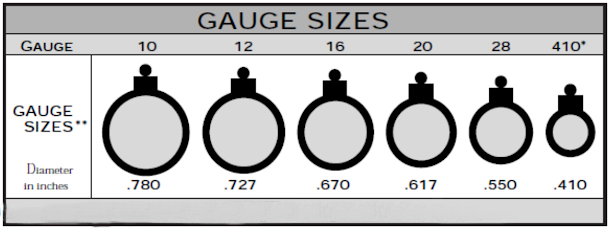Shotguns are available in a wide variety of different bore sizes,
actions, and configurations depending on their primary intended use, but there can often be considerable overlap between these roles.
Caliber and Gauge
When first learning about shotguns, bore size may be confusing. Other than the diminutive .410, shotgun barrel
diameter is defined by a gauge number. This is calculated by counting the number of lead balls, the diameter of which are the same as the bore of the shotgun, which total
one pound. A 12 gauge would need 12 balls of 0.727 inches, whereas a 20 gauge would require twenty balls of 0.617 inches.
As mentioned above, the exception to this are .410 shotguns, which have a caliber designation. Using the above system, they would be considered just
over 67 gauge; conversely, 12 gauge is around .73 caliber.
Patterning Shot
Whether birdshot or buckshot, when using shells loaded with multiple pellets the chosen load needs to be patterned, a method of testing
to make sure the density of pellets is sufficient for the purpose intended. This process is well understood and involves shooting at a
large target at a specific range, such as a four foot square at 40 yards, then
counting pellet hit percentages while keeping an eye out for voids in the
pattern. Here are two references
on the procedure of patterning a shotgun.
If firing slugs, a shotgun is sighted in using the same
techniques as any rifled long gun, though often at a shorter range.
Choke
One of the elements that effects pattern is barrel choke, which is a specific restriction at the end of the bore that either allows the
pellets to spread immediately or compresses them slightly to delay the
dispersal.
There are a variety of chokes available, but the five most
common are, from loosest to tightest: cylinder, improved cylinder, modified,
improved-modified and full choke. Most modern shotguns have removable chokes, so they
can be changed as needed.
Depending on the intended use of the shotgun, one of these
will be optimal, though often one of the adjacent chokes will be acceptable.
Actions
A selection of the author's shotguns
There are a number of different operating mechanisms for shotguns, but the three most common are break-open double barreled shotguns (either "over-under" or side by side), pump, and semi-auto. While popular for a
long time, single shot and bolt action shotguns are of less interest to the
buying public these days.
Configuration
In addition to actions, shotguns are also set up for a
variety of uses. While there can be considerable overlap between them, there
are specific features that benefit certain purposes.
- Skeet: These will have mid-length barrels (26" is fairly popular) and are often of lighter construction than other shotguns. Double barrel and semi-auto dominate this type.
- Trap: Shotguns intended for trap will have longer barrels, but are otherwise similar in setup to skeet shotguns. Barrels over 32" aren't uncommon.
- Hunting, ground: When going for small game such as squirrels or rabbits, shotguns will often have barrels slightly shorter than those used for skeet (24-26") and will usually weigh more being of heavier construction. Pump and semi-auto seem to be most prevalent here.
- Hunting, waterfowl: Longer barreled (28-30") semi-autos rule the roost (heh) for this use.
- Defensive: As 18" is the legal minimum without getting into the National Firearms Act of 1934, most shotguns designed for defensive purposes have 18 ½" barrels. They may also have additional "tactical" elements such as attached shell holders, adjustable stocks, slings, barrel heat shields, and even bayonet lugs. The most popular type in this configuration is pump-action.
In the shotgun world, there are many different options in both form and function. As such, there should be something for everyone.
Have fun, and safe shooting.





No comments:
Post a Comment